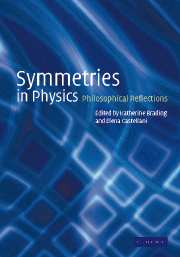Book contents
- Frontmatter
- Contents
- List of contributors
- Preface
- Copyright acknowledgements
- 1 Introduction
- Part I Continuous symmetries
- 2 Classic texts: extracts from Weyl and Wigner
- 3 On continuous symmetries and the foundations of modern physics
- 4 The philosophical roots of the gauge principle: Weyl and transcendental phenomenological idealism
- 5 Symmetries and Noether's theorems
- 6 General covariance, gauge theories, and the Kretschmann objection
- 7 The interpretation of gauge symmetry
- 8 Tracking down gauge: an ode to the constrained Hamiltonian formalism
- 9 Time-dependent symmetries: the link between gauge symmetries and indeterminism
- 10 A fourth way to the Aharonov–Bohm effect
- Part II Discrete symmetries
- Part III Symmetry breaking
- Part IV General interpretative issues
- Index
5 - Symmetries and Noether's theorems
Published online by Cambridge University Press: 08 October 2009
- Frontmatter
- Contents
- List of contributors
- Preface
- Copyright acknowledgements
- 1 Introduction
- Part I Continuous symmetries
- 2 Classic texts: extracts from Weyl and Wigner
- 3 On continuous symmetries and the foundations of modern physics
- 4 The philosophical roots of the gauge principle: Weyl and transcendental phenomenological idealism
- 5 Symmetries and Noether's theorems
- 6 General covariance, gauge theories, and the Kretschmann objection
- 7 The interpretation of gauge symmetry
- 8 Tracking down gauge: an ode to the constrained Hamiltonian formalism
- 9 Time-dependent symmetries: the link between gauge symmetries and indeterminism
- 10 A fourth way to the Aharonov–Bohm effect
- Part II Discrete symmetries
- Part III Symmetry breaking
- Part IV General interpretative issues
- Index
Summary
Introduction
Emmy Noether's greatest contributions to science were in algebra, but for physicists her name will always be remembered for her paper of 1918 on an invariance problem in the calculus of variations. The most celebrated part of this work, associated with her ‘first theorem’, has to do with the connection between continuous (global) symmetries in Lagrangian dynamics and conservation principles, though the main focus of the paper was the relationship between this and the second part of her paper, where she gives a systematic treatment of the more subtle and general case of continuous local symmetries (symmetries depending on arbitrary functions of the spacetime coordinates).
The connection between global or ‘rigid’ symmetries and conservation principles in classical mechanics was hardly news in 1918. As Kastrup (1987) discusses in his historical review, it had been appreciated in the previous century by Lagrange, Hamilton, Jacobi, and Poincaré, and an anticipation of Noether's first theorem in the special cases of the 10-parameter Lorentz and Galilean groups had been given by Herglotz in 1911 and Engel in 1916, respectively. Noether's own contribution is often praised for its degree of generality, and not without reason. But interestingly it does not cover the cases in which the symmetry transformation preserves the Lagrangian or Lagrangian density only up to a divergence term. It does not therefore cover such cases as the boost symmetry in classical pre-relativistic dynamics, although modern treatments of Noether's first theorem commonly rectify this defect.
- Type
- Chapter
- Information
- Symmetries in PhysicsPhilosophical Reflections, pp. 89 - 109Publisher: Cambridge University PressPrint publication year: 2003
- 26
- Cited by



